The Cook's Illustrated Cookbook (197 page)
Read The Cook's Illustrated Cookbook Online
Authors: The Editors at America's Test Kitchen
Tags: #Cooking

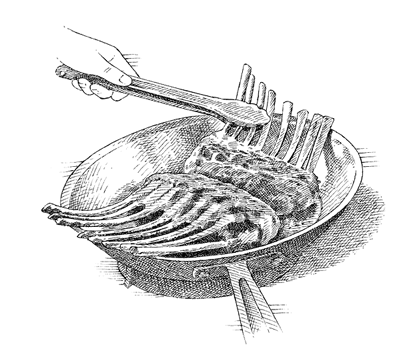
1.
Place racks in hot pan with meat in center and ribs facing outward.
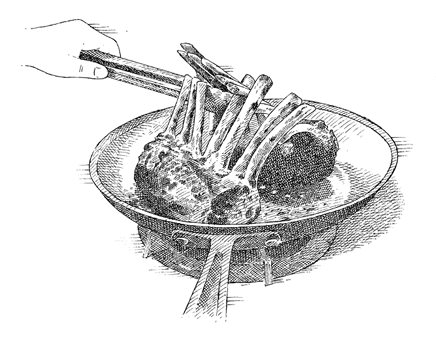
2.
After meat is browned, stand racks up in pan and lean them against each other to brown bottoms.
![]() WHY THIS RECIPE WORKS
WHY THIS RECIPE WORKS
Few roasts make as grand an entrance as roasted leg of lamb, but its charm quickly fades upon carving—copious amounts of sinew and fat make serving this roast a challenge, while lamb fat is the key source of the musky flavor that even adventurous eaters can find off-putting. We wanted a roasted leg of lamb without the gristle or gaminess. We started with a meaty, boneless shank-end roast for best flavor and easy carving. We then separated the meaty lobes to create three tidy mini-roasts from which we could easily trim away all visible fat and gristle, thus eliminating gamy flavor. Next, we introduced garlic and herb flavors to our lamb with a seasoned brine. Finally, we added even more garlic flavor by rubbing a roasted garlic paste onto one side of the lamb.
SERVES 8 TO 10
Look for rolled, boneless leg of lamb wrapped in netting, not butterflied and wrapped on a tray. The desirable cut is the “shank end,” which is the whole boneless leg without the sirloin muscle attached. If only bone-in or semiboneless leg is available, ask your butcher to remove the bones for you. Plan on spending about 30 minutes trimming the lamb of fat and silver skin. This advance work is well worth the effort; your roasts will present elegantly and have a much cleaner flavor. (That said, even 10 minutes of trimming will improve the taste dramatically). If you opt for the 30-minute trim, you will have enough meat scraps left over to make the Roasted Garlic Jus (recipe follows).
LAMB AND BRINE
¹⁄ | cup sugar |
2 | tablespoons salt |
12 | garlic cloves, crushed |
1 | (5- to 7-pound) boneless leg of domestic lamb with sirloin muscle removed, separated into 3 smaller roasts, trimmed, and scored |
GARLIC-PARSLEY PASTE
2 | garlic heads, outer papery skins removed and top third of head cut off and discarded |
1 | tablespoon olive oil |
2 | tablespoons minced fresh parsley |
Salt and pepper | |
3 | tablespoons vegetable oil |
1. FOR THE LAMB AND BRINE:
Dissolve sugar and salt in 2 quarts water in large container; stir in crushed garlic. Submerge lamb in brine, cover, and refrigerate for 2 hours.
2. FOR THE PASTE:
While lamb brines, adjust oven rack to middle position and heat oven to 400 degrees. Place garlic heads cut side up on sheet of aluminum foil and drizzle with olive oil. Wrap foil tightly around garlic; place on baking sheet and roast until cloves are very soft and golden brown, 40 to 45 minutes. When cool enough to handle, squeeze garlic head to remove cloves from skins. Mash cloves into paste with side of chef’s knife. Combine 2 tablespoons garlic paste and parsley in small bowl. (Reserve remaining paste for Roasted Garlic Jus, if making; recipe follows.)
3.
Remove lamb from brine and thoroughly pat dry with paper towels. Rub surface of lamb with garlic paste, roll, and tie with kitchen twine at 1-inch intervals. Season each roast with salt and pepper.
4.
Heat vegetable oil in 12-inch ovensafe skillet over medium-high heat until shimmering. Place lamb roasts in skillet and cook until well browned on all sides, about 12 minutes total. Place skillet in oven and roast until each roast
registers 120 to 125 degrees (for medium-rare) or 130 to 135 degrees (for medium). (Roasting time will range from 8 to 25 minutes depending on size of roasts; begin checking after 7 minutes and transfer each roast to platter as it reaches desired temperature.)
Let lamb rest, tented loosely with foil, about 15 minutes. Snip off twine, cut into ¹⁄
4
-inch slices, and serve.
TO MAKE AHEAD:
Lamb can be trimmed, brined, rubbed with paste, and tied, then stored overnight in refrigerator (do not season meat). Allow lamb to stand at room temperature for 30 minutes before proceeding with recipe.
MAKES ABOUT 2 CUPS
Trimming the lamb into three roasts will yield a few large, meaty scraps, which we recommend using to make an accompanying jus. (Discard smaller pieces of fat and silver skin.) Start the jus while the lamb is in the oven, and finish simmering it while the lamb rests. Keep it warm in a small saucepan and return to a simmer just before serving.
1 | tablespoon vegetable oil |
1–1¹⁄ | cups meaty lamb scraps, trimmed of fat and cut into 1-inch pieces |
1 | onion, chopped |
¹⁄ | cup dry white wine |
4 | cups low-sodium chicken broth |
2 | tablespoons garlic paste (reserved from Garlic-Roasted Leg of Lamb) |
1 | teaspoon red wine vinegar |
Heat oil in Dutch oven over medium-high heat until shimmering; add lamb and onion and cook, stirring occasionally, until lamb is well browned and onion is soft and golden, about 8 minutes (reduce heat to medium if pan becomes very dark). Add wine and simmer until reduced by half, about 1 minute, scraping bottom of pot with wooden spoon to loosen any browned bits. Add broth and garlic paste; simmer until reduced by half, 15 to 20 minutes. Add any accumulated lamb juices from platter. Strain jus through fine-mesh strainer into small saucepan; add vinegar and serve with sliced lamb, or keep warm until needed.
This method takes about 30 minutes. Instead, you can simply separate the lamb into 3 roasts (illustration 1) and spend just 10 minutes trimming, concentrating on the exterior fat and gristle, then cut a deep, lengthwise pocket into each roast, rub the paste on the interior surface, and tie the roasts.
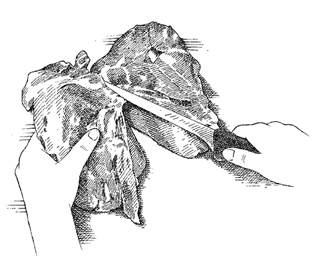
1.
Following natural seams (delineated by lines of fat), separate into 3 smaller roasts, using sharp boning knife as needed.
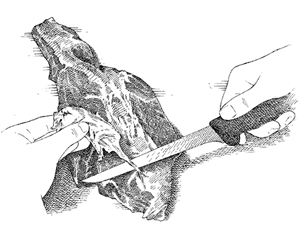
2.
Trim visible fat and gristle from exterior of each roast. Penetrate deeper to remove interior pockets of gristle, fat, and silver skin. (Roasts will open up and flatten slightly.)
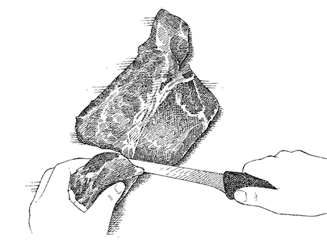
3.
As you trim meat, remove any large, meaty scraps that come loose from larger pieces. Reserve these for making Roasted Garlic Jus (see related recipe), if desired.
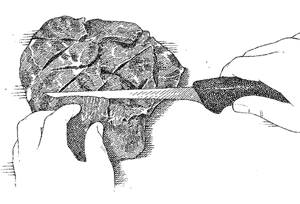
4.
Lightly score inside of each roast, making ¹⁄
4
-inch-deep cuts spaced 1 inch apart in crosshatch pattern.
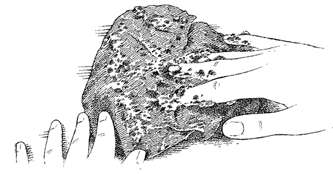
5.
Rub scored surface of brined lamb with garlic-parsley paste, working paste into grooves.
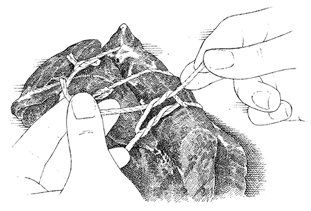
6.
Roll into compact roast, tucking in flaps, to form log shape. Tie with kitchen twine at 1-inch intervals.
